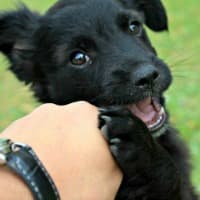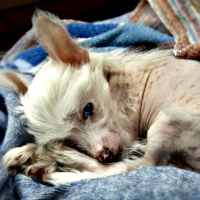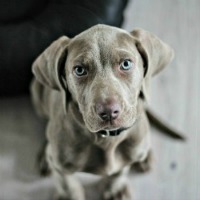Puppy Behavior
Puppy behavior can be ridiculously adorable, or unbelievably frustrating.. and a whole lot more in between.
Behavior in puppies is shaped by a variety of things including:
- Breed-specific traits
- Genetic makeup
- Individual personality
- Temperament of the momma dog
- Litter size
- Handling & care in the early weeks
- Quality/quantity of training and socialization
As humans we often don't understand the canine instincts behind natural puppy behaviors, and this leads to confusion, worry and sometimes even fear.
One of the most common worries that new puppy owners have when it comes to behavior problems is that their puppy is 'aggressive'.
This is almost never the case, in fact true aggression in puppies is almost non-existent.
Nipping, biting, growling and barking are completely normal actions for puppies of all breeds, but they do need to be discouraged so that your pup learns the right way to behave in his new, human-oriented world.
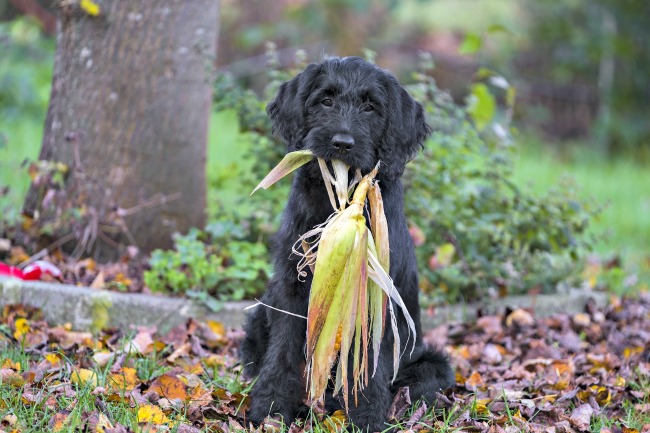
Other things which come naturally to your little Rascal can cause you problems including:
- Chewing everything in sight
- Guarding his food or toys
- Being bossy or pushy with children
- Becoming overly anxious or fearful in non-threatening
The good news is that with time, patience, love and the right training and encouragement you can eliminate all of these.
Sometimes puppy behavior can seem cute, or even funny, when little Rascal is a tiny little furball.
But if that same behavior won't be so amusing when he's bigger and stronger, start correcting him right away.
Never allow your pup to build up a habit of doing something you won't want him to do later on. It's a recipe for frustration on your part and confusion on his.
- How to Correct Puppy Mis-behavior
- Biting & Nipping
- Chewing
- Resource Guarding
- Growling
- Being Bossy Around Kids
Puppies have a LOT of genetically programmed traits and behaviors (on top, of course, of their physical genetic traits!). A recent study done by the University of Arizona School of Anthropology in the College of Social and Behavioral Sciences has added to what we know about a puppy's willingness and ability to communicate with humans.
Studying 375 eight week old puppies (from 117 different litters) who were destined to be service dogs, the study determined that puppies are able to communicate with and understand human physical and verbal cues from an early age.
As these puppies were still living with their littermates and had limited one-on-one interaction with humans, these abilities would seem to be present at birth and have a genetic component. This will of course vary depending on breed, individual puppy personality etc. but it's interesting to know that this communication skill isn't just a learned behavior.
You can read more about this study HERE
Correcting Bad Puppy Behavior
Although puppy misbehavior can be frustrating, it's important to remember that your puppy isn't being naughty on purpose, he's simply being a baby a dog.
There are lots of different ways to correct puppy behavior problems, but in order for them to be effective they have to be used consistently and with love.
It's important to never treat your puppy harshly and never to scare or hurt him. Never hit or smack.
Raising your voice isn't necessary, don't shout.
Puppies are very intuitive and they react to the emotional level of a situation. If you shout it raises those levels and little guy may shout back.
A low, firm voice is much more effective when disciplining a puppy.
The same goes for your actions.
Staying calm, even if you're frustrated, will make you a much more effective teacher and help Rascal stay calm too.
If you're stomping and shouting and red in the face, your puppy is most likely going to be barking and jumping running around as he mirrors your agitation.
Or, even worse, he's going to be afraid and anxious and trying to hide.
Neither will help the situation.
Your puppy doesn't know what he did wrong... he probably doesn't even understand that it's his behavior that has you all upset!
One final tip:
You MUST correct your puppy every time you see the behavior, consistency is key.
If he's allowed to pull at your pant legs one day, but not the next he will be confused and the lesson will take much longer to be learned.
Puppy Behavior - Nipping & Biting
Biting or nipping is one of the most common puppy behaviors, and also one which causes owners a lot of worry and frustration.
All puppies nip, it's part of natural canine interaction and communication.
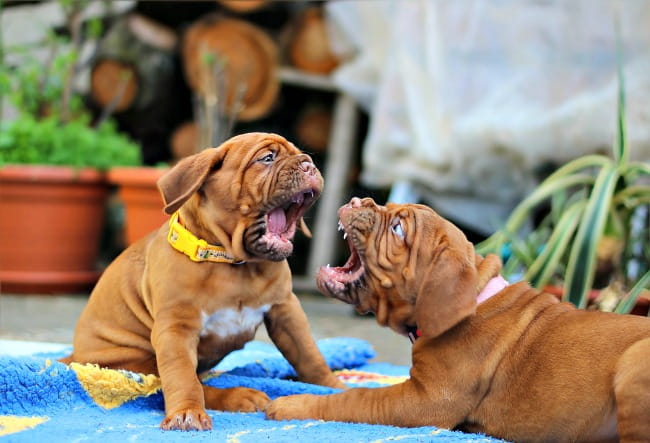
Some breeds (including herding and retrieving breeds due to their breed-specific traits) can be especially 'mouthy', and some individual puppies can be more inclined to bite or nip than others depending on their personalities.
No matter how dedicated he is to being nippy, any puppy can learn that this isn't acceptable behavior with the right approach, training and consistency.
Because this is such a common problem, and also because there are several different ways to discourage it, I've created a page specifically to deal with it.
Check it out here.... Stop Puppy Biting.
My Puppy Chews Everything!
Of course he does. Chewing is another totally natural puppy behavior.
Puppies explore the world with their mouths, just like human babies do really. It's also a natural stress relieving activity for puppies and dogs of all ages.
This behavior peaks during the teething stage, and gradually decreases as they mature.
Adult dogs still enjoy chew toys, and will chew more when anxious, or bored.
As long as you train him properly when he's young, chances are Rascal will confine his chewing to HIS toys and not your furniture when he's all grown up.
How To Handle Puppy Chewing
Notice I didn't say 'How to STOP Puppy Chewing' there.
That's because you can't stop a puppy or dog from chewing, neither should you want to.
The way to handle this puppy behavior is to teach little Rascal that there are certain things he can chew on, and a lot more that he can't.
There are two parts to this correction.
First of all, you need to puppy proof your home as completely as possible. By removing as many tempting, but off-limits, items from Rascals' reach you make your job easier.
Secondly, it's important to correct your little guy EVERY SINGLE TIME you see him sharpening his pearly whites on something that is not a chew toy.
- Give a verbal correction, eg. 'No chew' or 'No, not yours'
- Remove forbidden object or move Rascal away from it
- Give him one of his own toys and encourage him to chew on it instead
This will not be a quick fix. It takes a while for a young puppy to realize that there are only a few of the things in his world which he's allowed to munch on.
But he will learn given time, patience and repetition.
Luckily there are a huge variety of puppy chew toys which are safe, fun and often tasty too.
Invest in at least half a dozen and rotate them out so that he has a different two or three every day.
Check out some of the best natural chews for puppies HERE, and some great puppy teething toys HERE.
Puppies have short attention spans and this helps prevent your little guy from getting bored too quickly.
Resource Guarding
Resource guarding is what your puppy is doing when he tries to protect his food/toys by growling or nipping.
Again, as with all the other puppy behaviors on this page, guarding resources is a completely natural one.
Puppies, like human babies/toddlers, don't want to share.
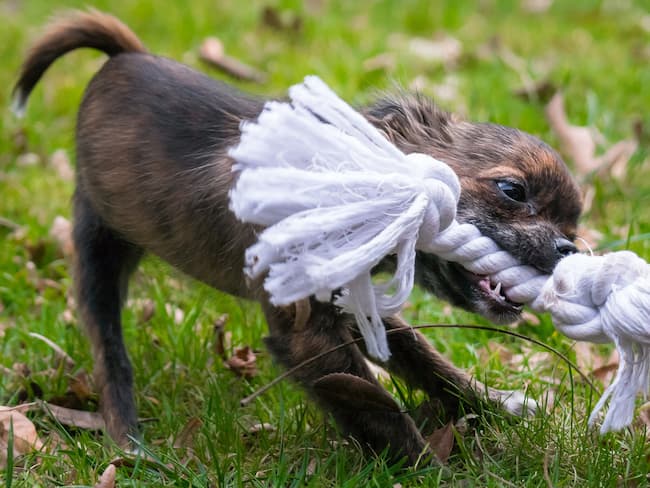
But, because your pup will use his teeth to protect what's important to him, it's important to discourage this behavior... or even better, stop if from happening in the first place.
If your puppy was one of a large litter he may have had to fight for his place at the food bowl, or for toys or attention.
Also, a pup with a dominant, strong or push personality may want the lions share of whatever resources are available.
Most times he'll carry this behavior into his new home.
Some puppies don't have these early experiences, or are submissive by nature, and don't feel the need to guard things to begin with. But this can change as they mature.
Puppies and dogs usually place the highest value on food, treats and bones, or tasty toys.
They may also want to guard other toys, sleeping spots, people and so on.
The earlier you work on discouraging this behavior, or not allowing it to start, the better.
Guarding His Food Bowl
Puppies, and adult dogs, usually only guard the things they really love, and anything edible always falls into that category!
Little Rascal's food bowl is a prime target for resource guarding and it's important to get him familiar with having your hands near, and IN, his bowl and around his food right from day one.
There are a couple of ways to do this and I'd recommend doing them both.
Hand Feeding Your Puppy
For the first two weeks feed your puppy one of his meals (or at least part of one meal) by hand.
Have the food in his bowl in your lap and offer it to him in the palm of your hand.
It's easier for him to eat it that way and you're less likely to have your fingers nibbled countless times.
This teaches him that you, not his bowl, are the source of his food.
It also helps him see your hands and his food together as a positive thing.
After the first two weeks you can hand feed him one meal every two or three days and gradually decrease that over time so that by the time he's several months old he gets hand fed just once or twice a month.
Eventually as an adult dog, the occasional hand-feeding will keep this lesson fresh in his mind.
Controlling Feeding Times
Teaching little Rascal to be calm at mealtimes and to wait until you give him the 'okay' to eat will help him feel less possessive about his food, and also lower his emotional reaction to his food.
Once his food is in his bowl, ask Rascal to 'Sit' and have him wait while you put the bowl down. He can't jump in until you say the trigger word such as 'Okay', 'Take It' or something similar.
Obviously tiny puppies have great difficulty with this because they're not old enough to be able to control themselves or have the attention span to have learned 'Sit' and 'Stay' or 'Wait'.
So, to begin with you will have to hold little Rascal back gently and don't expect him to 'wait' quietly!
A couple of seconds of him being still is all you need at this point. You're setting the stage for the lesson. Over time he'll perfect it.
Teaching Rascal To Tolerate People Around His Bowl
A puppy or dog who snaps at someone who gets their hands (or themselves) too close to his dish is dangerous.
Teach little Rascal to tolerate you, your partner, your children and any human being being around his bowl by making sure you're around him at mealtimes.
Don't feed him in an isolated area or leave him by himself to eat.
Keep a stash of healthy treats (or raw/freeze-dried tidbits) and every now and reach down and drop one into his bowl.
Over time build up to putting your hand directly into his bowl and placing the treat on top of his food.
Have every family member work on this regularly.
You want your pup to see any person, or any hands coming towards his bowl as a gift, not a threat.
If your puppy comes into your home with food guarding issues, take things very slowly so as not to scare him or provoke a bite.
Young puppies learn very quickly and if they have any bad habits like this they lose them quickly too.
Adult dogs with food or resource guarding issues are another story and that takes a lot of work and a lot of time to fix... and needs to be approached with caution.
Guarding Toys or Treats
The best way to make sure your little Rascal doesn't get all possessive over his toys or treats is to teach him how to 'Drop It' or 'Leave It'.
Once he's learned this basic obedience command he'll give up whatever it is he has when asked for it. Yes, really.
The trick is to make sure it's an exchange to begin with, and not a take-over!
Begin with low-value items (from your puppy's point of view) meaning toys rather than naturalbones, bully sticks, antlers, or flavored/edible toys.
Once he's mastered the lesson with these you can move onto the stuff he really loves.
Start teaching 'Leave It' as a fun game and your little guy will join in and not even realize he's learning:
- When he's playing with a toy, go up to him and say 'Rascal, leave it' in an upbeat voice.
- Remove the toy from his paws/mouth gently (no tug of war)
- Say 'Good boy' and give him a treat
- Give him BACK his toy and tell him he's a good boy
Lesson over!
Puppy Growling
Growling is another puppy behavior which is totally normal, and is your pup's attempt to communicate his opinion to you.. usually one of displeasure!
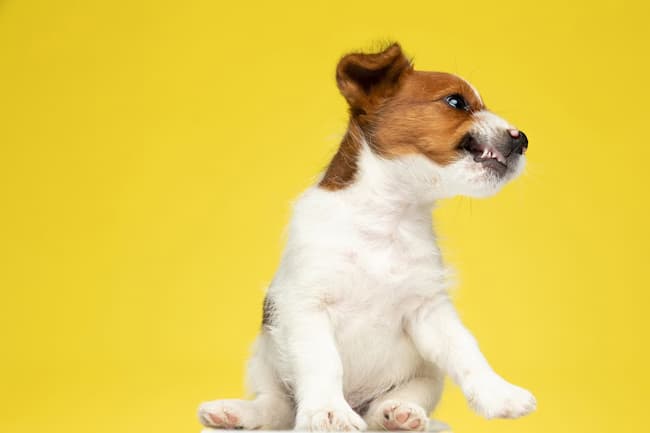
- Rascal doesn't want to be picked up? He growls.
- He doesn't want to give up his bone? He growls.
- He wants to stay on the sofa when he's not allowed up there? He growls.
These are all totally familiar, and as his voice (and his teeth) are his only means of communication we can't really blame the little guy.
He's a baby, and like a baby he wants his own way and will use whatever means he can to get it.
The key to discouraging growling is to make sure that it NEVER gets little Rascal what he wants.
For example, if he growls when you pick him up, don't put him down!
Instead, tell him 'No growl' in a low, firm voice and continue to hold him/carry him until you're ready to put him down.
If he keeps growling or even snaps at you, use the muzzle wrap technique described on my Stop Puppy Biting page HERE.
If he growls at you when you try to take his favorite bone, tell him 'No growl' and remove it anyway. Then start teaching him the Leave It command as talked about HERE.
Don't get angry or scared, be calm and firm, and don't allow his behavior to shape yours.
Being 'Bossy' Around Kids
It's pretty common for puppies to behave differently towards children than towards adults.
Puppies seem to recognize children as being 'babies' like themselves and treat them more like litter-mates than as authority figures.
Natural puppy sibling interaction involves a lot of nipping, biting, growling, jumping and rough-housing and although it's play, it's also how pack structure is worked out and dominant/submissive relationships formed.
When little Rascal behaves this way with his human litter-mates it can cause trouble.
Un-checked it can lead to more serious dominance issues later with a puppy, or dog, who is bigger and stronger than the child.
So... teach your little Rascal that your children are authority figures, NOT puppies, and start right away.
- Involve your children in feeding, grooming and training your puppy - daily
- Show them how to correct nipping or growling
- Teach them to be calm around the puppy and use quiet voices
- Discourage screaming/squealing/running which triggers prey drive in pups/dogs
The above works for school-age children.
If you have toddlers in the family you'll need to help them until they're old enough to participate themselves.
Always supervise your puppy around your kids and step in if they're not able to control little Rascal's rambunctiousness.
You Might Also Like:
- Home
- Puppy Behavior
